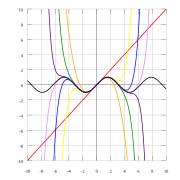HEre's the taylor series for f(x+  ) .
) .
It is a simple expansion series of any function  around a small increment
around a small increment  .
.

Where  are higher order terms (greater than the power of three). If we ignore
are higher order terms (greater than the power of three). If we ignore
the higher order terms as well as the third order term then we can write:

And in the limiting case when  we have
we have

If you carefully look at the above equation then we will see a striking resemblance
to the famous Ito's stochastic equation, which is the basis of Black-Scholes option
pricing partial differential equation (PDE). The only difference is that in Ito's
equation we have the term  instead of
instead of  , that is in an Ito process we have
, that is in an Ito process we have

The above equivalence has a great intuitive meaning with respect of geometric Brownian motion and asset price movement, but that is not the purpose of this article. What we wanted to show was that even without any knowledge of stochastic calculus and the corresponding Ito process one can approach the Black-Scholes option pricing PDE if one were to make the accommodation shown above. It also shows that any asset price movement, such as the movement of a bond, can be approximated by the Taylor series expansion and regardless of whether we know the exact closed form solution for the pricing of that asset, it is possible,
using first principles of differential calculus to approximate the movement of the asset over small increments of state space and time.
In keeping with our arguments above let us show you that the Taylor series expansion can be used to calculate the value of any variable with a great degree of precision and speed, which may not be possible numerically.
Say, you wanted to calculate the value of  , that is eleven raised to the power of eight. Doing this manually could take you forever. Of course, you can do it in less than a second using a scientific calculator or an Excel spreadsheet. But suppose you don't have an Excel spreadsheet (or a calculator near you) and you wanted a quick approximation of this number.
, that is eleven raised to the power of eight. Doing this manually could take you forever. Of course, you can do it in less than a second using a scientific calculator or an Excel spreadsheet. But suppose you don't have an Excel spreadsheet (or a calculator near you) and you wanted a quick approximation of this number.
You can say that  and that a small increment of
and that a small increment of  is one and therefore,
is one and therefore,
 and
and . First we calculate the value of
. First we calculate the value of  which is very
which is very
straightforward and simple: 100,000,000. We need to use the Taylor series to
calculate the change in value of this number around the point  . (Remember
. (Remember
by making x = 10, we have made all our calculations very simple and that is where
the usefulness of Taylor series lies)
Now using Taylor series for calculation we get:



Thus the change in the value of the function f which is given by  is:
is:

And the value of the function is approximated as:

This is quite good an approximation given the fact that if you were to use your Excel spreadsheet then for 11^8 (eleven raised to the power of eight) you would get 214,358,881.





